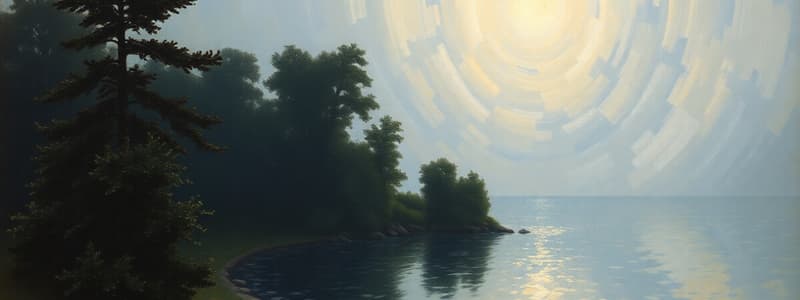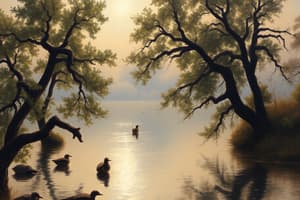Podcast
Questions and Answers
Prehistoric kala ke mukhya uddeśya kī hai?
Prehistoric kala ke mukhya uddeśya kī hai?
Prehistoric kala ke mukhya uddeśya ritualistic aur communicative bhavnaan hain.
Medieval art ke kuch pramukh visheshata kaun-se hain?
Medieval art ke kuch pramukh visheshata kaun-se hain?
Medieval art religious themes ke liye jaana jaata hai aur kuch notable styles hain Byzantine, Romanesque, aur Gothic.
Renaissance mein art ke koun se mukhya vikas dekhe gaye?
Renaissance mein art ke koun se mukhya vikas dekhe gaye?
Renaissance mein perspective, chiaroscuro, aur humanism ka vikas hua, jo classical learning ke revival ka praman hai.
Baroque art ki visheshata kya hai?
Baroque art ki visheshata kya hai?
Romanticism ke pramukh vishay kya hain?
Romanticism ke pramukh vishay kya hain?
Impressionism ka pramukh vishay kya hota hai?
Impressionism ka pramukh vishay kya hota hai?
Modern art ke kuch pramukh movements kaun se hain?
Modern art ke kuch pramukh movements kaun se hain?
Contemporary art ka kya mahatva hai?
Contemporary art ka kya mahatva hai?
Prehistoric kala ke pramukh udaharan kaun se hain?
Prehistoric kala ke pramukh udaharan kaun se hain?
Greek art ka pramukh visheshata kya hai?
Greek art ka pramukh visheshata kya hai?
Baroque kala mein roshni aur chhaya ka kaise istemal hota hai?
Baroque kala mein roshni aur chhaya ka kaise istemal hota hai?
Neoclassicism kala ke pramukh udaharan kaun se hain?
Neoclassicism kala ke pramukh udaharan kaun se hain?
Romanticism kala ka mukhya vishay kya hai?
Romanticism kala ka mukhya vishay kya hai?
Modern art ke kaun se mukhya movements hain?
Modern art ke kaun se mukhya movements hain?
Contemporary art ka mahatva kya hai?
Contemporary art ka mahatva kya hai?
Art ke pramukh madhyam kaun se hain?
Art ke pramukh madhyam kaun se hain?
Flashcards are hidden until you start studying
Study Notes
Art History
-
Definition: The study of visual arts through different time periods and cultures.
-
Prehistoric Art:
- Cave paintings (e.g., Lascaux, France)
- Sculptures (e.g., Venus figurines)
- Purpose: Ritualistic and communicative functions.
-
Ancient Art:
- Egyptian: Hieroglyphics, tomb paintings, monumental sculptures (e.g., Sphinx).
- Greek: Pottery, sculptures reflecting ideals of beauty (e.g., statues of gods).
- Roman: Realism in portraiture, frescoes, and mosaics.
-
Medieval Art:
- Characterized by religious themes.
- Notable styles: Byzantine, Romanesque, and Gothic.
- Important works: Illuminated manuscripts and cathedrals (e.g., Notre Dame).
-
Renaissance (14th to 17th century):
- Revival of classical learning and art.
- Key figures: Leonardo da Vinci, Michelangelo, Raphael.
- Innovations: Use of perspective, chiaroscuro, and humanism.
-
Baroque (17th to 18th century):
- Dramatic use of light and shadow, emotion.
- Key artists: Caravaggio, Rembrandt, Peter Paul Rubens.
- Architecture: Grandiose designs (e.g., St. Peter's Basilica).
-
Rococo (18th century):
- Ornate, playful, and exuberant style.
- Key figures: Antoine Watteau, François Boucher.
- Focus on themes of love, nature, and the aristocracy.
-
Neoclassicism (mid-18th to early 19th century):
- Inspired by classical antiquity.
- Key artists: Jacques-Louis David, Jean-Auguste-Dominique Ingres.
- Emphasis on order, symmetry, and stoicism.
-
Romanticism (late 18th to mid-19th century):
- Focus on emotion, nature, and individualism.
- Key figures: Eugène Delacroix, Caspar David Friedrich.
- Reaction against industrialization and rationalism.
-
Impressionism (19th century):
- Focus on light, color, and everyday scenes.
- Key artists: Claude Monet, Edgar Degas, Pierre-Auguste Renoir.
- Use of short brush strokes and open composition.
-
Modern Art (late 19th to 20th century):
- Includes various movements: Cubism, Surrealism, Dadaism.
- Key figures: Pablo Picasso, Salvador Dalí, Marcel Duchamp.
- Themes: Abstraction, experimentation, and breaking conventions.
-
Contemporary Art (late 20th century to present):
- Diverse styles and media (e.g., installation art, digital art).
- Focus on social issues, globalization, and identity.
- Key movements: Postmodernism, street art, and conceptual art.
-
Art Movements:
- Understand the context and characteristics of each movement.
- Recognize key artists and their contributions.
-
Cultural Influences:
- Art as a reflection of socio-economic and political changes.
- Interaction between different cultures and art forms.
-
Methodology:
- Art criticism and analysis based on form, content, and context.
- Importance of historical context in understanding art.
कला इतिहास: एक भाषा
- कला इतिहास विभिन्न समय काल आ संस्कृतियों से देखल जात दृश्य कला के अध्ययन छ।
प्रागैतिहासिक कला
- गुफा चित्रकारी (जैसे लास्को, फ्रांस)
- मूर्तियाँ (जैसे वीनस मूर्तियाँ)
- उद्देश्य: धार्मिक आ संचार के काम
प्राचीन कला
- मिस्र: हिरोग्लिफ़िक्स, मकबरे में चित्रकारी, बड़ मूर्तियाँ (जैसे, स्फ़िंक्स)
- ग्रीक: मिट्टी के बर्तन, सुंदरता के आदर्शों को दर्शानेवाला मूर्तियाँ (जैसे, देवताओं की मूर्तियाँ)
- रोमन: पोर्ट्रेट में यथार्थवाद, भित्तिचित्र आ मोज़ेक
मध्ययुगीन कला
- धार्मिक विषयों से भरल कला
- ध्यान खींचेवाला शैली: बाइजेंटाइन , रोमनस्क्यू , आ गॉथिक
- महत्वपूर्ण काम: प्रकाशित पाण्डुलिपियाँ आ कैथेड्रल (जैसे नोट्रे डेम)
पुनर्जागरण (14वीं से 17वीं शताब्दी)
- क्लासिकल शिक्षा आ कला का पुनरुद्धार
- मुख्य व्यक्तित्व: लिओनार्डो दा विंची,. माइकल एंजेलो, राफेल
- नवाचार: परिप्रेक्ष्य, चियारोस्कुरो आ मानवतावाद का उपयोग
बारोक (17वीं से 18वीं शताब्दी)
- प्रकाश आ परछाई का नाटकीय उपयोग, भावना
- मुख्य कलाकार: कारावाज्जियो, रेम्ब्रांट, पीटर पॉल रूबेंस
- वास्तुकला: भव्य डिज़ाइन (जैसे, सेंट पीटर बेसिलिका)
रोकोको (18वीं शताब्दी)
- अलंकृत, खेल आ उत्साही शैली
- मुख्य व्यक्तित्व: एंटोइन वॉटेओ, फ्रांस्वा बाउचर
- प्रेम, प्रकृति, आ कुलीनता के विषयों पर ध्यान
नवशास्त्रीयता (18वीं शताब्दी के मध्य से 19वीं शताब्दी के आरंभ तक)
- क्लासिकल प्राचीनता से प्रेरित
- मुख्य कलाकार: जैक-लुई डेविड, जीन-ऑगस्टे-डोमिनिक इंग्रेस
- क्रम, समरूपता, आ स्तंभवाद पर जोर
रोमांटिकता (18वीं शताब्दी के अंत से 19वीं शताब्दी के मध्य तक)
- भावना, प्रकृति, आ व्यक्तिवाद पर ध्यान
- मुख्य व्यक्तित्व: यूजीन डेलारोइक्स, कैस्पर डेविड फ्रेडरिक
- औद्योगीकरण आ तर्कवाद के खिलाफ प्रतिक्रिया
इंप्रेशनवाद (19वीं शताब्दी)
- प्रकाश, रंग, आ रोजमर्रा के दृश्यों पर ध्यान
- मुख्य कलाकार: क्लॉड मोनेट, एडगर डेगास, पीटर-ऑगस्टे रिनॉयर
- छोटे ब्रश स्ट्रोक आ खुले रचना का उपयोग
आधुनिक कला (19वीं शताब्दी के अंत से 20वीं शताब्दी तक)
- विभिन्न आंदोलनों को शामिल करता है: क्यूबिस्म, सर्रियलिज़्म, डाडावाद
- मुख्य व्यक्तित्व: पैब्लो पिकासो, साल्वाडोर डाली, मार्सेल ड्यूचैम्प
- विषय: अमूर्तता, प्रयोग, आ परंपराओं को तोड़ना
समकालीन कला (20वीं शताब्दी के अंत से वर्तमान तक)
- विविध शैलियाँ आ माध्यम (जैसे, स्थापना कला, डिजिटल कला)
- सामाजिक मुद्दों, वैश्वीकरण, आ पहचान पर ध्यान
- मुख्य आंदोलन: पोस्टमॉडर्निज्म, स्ट्रीट आर्ट, आ अवधारणात्मक कला
कला आंदोलन
- प्रत्येक आंदोलन का संदर्भ आ विशेषताओं को समझना
- मुख्य कलाकारों आ उनके योगदान को पहचानना
सांस्कृतिक प्रभाव
- सामाजिक-आर्थिक आ राजनीतिक परिवर्तनों का प्रतिबिंब के रूप में कला
- विभिन्न संस्कृतियों आ कला रूपों के बीच परस्पर क्रिया
पद्धति
- रूप, सामग्री, आ संदर्भ के आधार पर कला आलोचना आ विश्लेषण
- कला को समझने में ऐतिहासिक संदर्भ का महत्व
Kala Ke Itihaas
- Kala ke iitihaas bahut badal-badal ke chala aawat hai, aur har samuh aur samaya ke kala mein alag alag baat rahe hai
- Eka chhoti suruvat se, kala painting, sculpture, architecture aur sajab-sajawa ke cheezon ke bare mein hai.
Aadhikaly Ke Kala
- Aadi manushya cave pe painting kar sake.
- Lascaux, France ke cave pe painting ke chhoti ke bahut achchha example hai
- Venus figurines ke bhi suru se banva hotae.
Purana Samay Ke Kala (3000 BCE - 500 CE)
- Mesopotamia: Ziggurats (upchaita madir), aur cylinder seals banva hotae
- Misr: Hieroglyphs (chitrakhar), pyramids, aur tomb paintings banava hotae
- Yunani Kala: Pottery aur sculpture (jaise ki Parthenon ) banava hotae.
- Roman Kala: Public monument, frescoes aur mosaic banava hotae.
Madhya Kal Ke Kala (500 - 1400)
- Christian dharm ke tema madhya kal ke kala mein pratidhanit hotae hai.
- Illuminated manuscripts bhi bahut popular rahe.
- Gothic architecture aur cathedral (jaise ki Notre-Dame) banva hotae.
Punarjagaran (14th - 17th Century)
- Classical tema ke punarjeevan aur humanism (Manushya ke bare mein jaane ke chawla)
- Leonardo da Vinci, Michelangelo, aur Raphael jaise baadshah kalakar rahe.
- Perspective aur naturalism (prakriti ke jaise) mein badal-badal aaye.
Baroque (17th Century)
- Roshni aur chhaya ke dramatic use; gati
- Caravaggio, Rembrandt, aur Bernini jaise jaane-maane kalakar rahe.
Neoclassicism (18th - 19th Century)
- Classical puratanta se prabhavit; tarkiikta par zor
- Jacques-Louis David aur Jean-Auguste-Dominique Ingres jaise jaane-maane kalakar rahe
Romanticism (late 18th - mid-19th Century)
- Bhaavana, prakriti aur vyaktva par zor
- Eugène Delacroix aur Caspar David Friedrich jaise jaane-maane kalakar rahe.
Aadhunik Kala (late 19th - 20th Century)
- Impressionism, Cubism, Surrealism jaise aandolan rahe.
- Vincent van Gogh, Pablo Picasso, aur Salvador Dalí jaise jaane-maane kalakar rahe .
Samakalin Kala (20th Century - Present)
- Bahut tarah ke kala prakta; installation art, digital art
- Minimalism, Conceptual Art, Street Art jaise aandolan
- Andy Warhol, Damien Hirst, Banksy jaise jaane-maane kalakar
Kala Tekhneek aur Madhyam
- Oil, acrylic, watercolor, sculpture, digital jaise bahut tarah ke madhyam.
- Fresco, engraving, collage, mixed media jaise bahut tarah ke tekneek.
Sanskritik Mahatva
- Samaj ke mulya, viswas aur iitihaas ke sandarbh ko prakasit karta hai.
- Kala sansarnikta aur vyaktva ke pratibhaav ke roop mein bhi kaam karata hai.
Studying That Suits You
Use AI to generate personalized quizzes and flashcards to suit your learning preferences.




